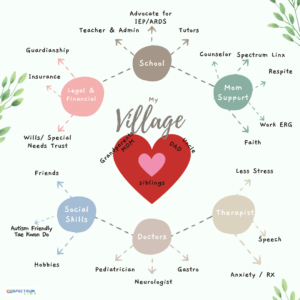By: Wendy Dawson
Technology is playing a crucial role in supporting individuals with autism by providing new ways to communicate, learn, and interact. Without getting into how much screen time is acceptable or the role of video games in an autistic individual’s day, here, we highlight some diverse applications and potential benefits of technological interventions for those with ASD, from educational aids to enhancing social communication skills and safety.
The Growing Role of Technology in Healthcare
In recent years, the integration of technology into healthcare has become increasingly prevalent, revolutionizing how services are delivered and accessed. This technological advancement is particularly significant for individuals with Autism Spectrum Disorder (ASD). By leveraging innovative tools and approaches, technology offers promising potential to enhance the quality of life and improved healthcare for individuals with ASD.
- Tele-health and virtual therapy – The acceptance of telehealth is paving the way for virtual diagnostics and therapeutic interventions. This capability offers a tremendous opportunity for families who previously could not travel for such services, either due to physical or geographical limitations, making healthcare more accessible and convenient. It enables access to specialists who may not be available locally, ensuring that patients receive expert care regardless of geographic location.
- Virtual assessment services – Virtual assessment is rapidly becoming more accessible, providing a convenient and effective way for individuals to receive evaluations and diagnoses from healthcare professionals. Advances in telehealth technology, coupled with widespread internet access, have enabled remote assessments, allowing patients to interact with clinicians through video calls and online platforms. This approach is particularly beneficial for individuals with autism, as it reduces the stress and logistical challenges associated with in-person visits. Virtual assessments also facilitate quicker access to specialists and tailored care plans, ensuring timely and comprehensive evaluations. As a result, virtual assessment is transforming healthcare by making diagnostic services more readily available and adaptable to the needs of diverse populations.
- Remote Monitoring – Wearable devices and mobile apps can track behaviors, sleep patterns, and other health metrics in real time, providing valuable data to healthcare providers.This data allows for more personalized and timely interventions, helping to address issues as they arise rather than waiting for scheduled appointments
Educational Technologies and Tools for Autism
In the realm of education, technological advancements have introduced a variety of tools designed specifically to assist individuals with Autism Spectrum Disorder (ASD). One such innovation is Computer-Aided Instruction (CAI) and specialized software, which provide programs tailored to teach academic skills. These programs offer significant benefits, including individualized learning experiences that cater to the specific needs and pace of each student, as well as interactive engagement that can make learning more appealing and effective.
Additionally, Virtual Reality (VR) and Augmented Reality (AR) have emerged as powerful tools, creating new environments where individuals with ASD can practice social skills and safety skills. These technologies allow for the safe simulation of real-world scenarios, providing a controlled environment where users can build confidence and competence as well as being able to virtually connect with other learning about social interactions
- Behavioral and Social Skills Support – Technology also plays a crucial role in supporting behavioral and social skill development for individuals with ASD. Video modeling and feedback techniques are widely used, where appropriate behaviors are demonstrated through videos, and positive behavior is reinforced. This method has proven to be highly effective in teaching and maintaining desirable behaviors.
- Communication Aids – Communication is a common challenge for many individuals with ASD, and technology has made substantial strides in this area as well. Augmentative and Alternative Communication (AAC) devices, such as speech-generating devices and specialized apps, offer essential support for non-verbal individuals, enabling them to express themselves more effectively. Furthermore, interactive apps and software designed to enhance language and social communication skills have become increasingly popular. These tools often incorporate game-like elements to motivate and engage users, making the learning process enjoyable and more likely to result in meaningful progress.
{BridgingApps© is a program of Easter Seals Greater Houston that provides resources, education, and information on apps and mobile devices to help caregivers and people with disabilities like autism, cerebral palsy, and Down syndrome target and improve skills and reach their highest levels of physical, social, and cognitive development.
BridgingApps includes a directory of apps along with app reviews by therapists and special education teachers, a custom app search engine, assistive technology labs, and training options for parents, organizations and schools.}
- Safety devices – Safety wearable technology for individuals with autism provides crucial support and peace of mind for both the individuals and their caregivers. For example, GPS-enabled tracking devices, like AngelSense, allow caregivers to monitor the location of their loved ones in real-time, ensuring they can be quickly found if they wander off. Smartwatches, such as the CarePredict Tempo Series 3, can monitor vital signs and alert caregivers to potential health issues or distress. Additionally, wearable communication devices, like the Proloquo4Text app on an Apple Watch, facilitate easier communication for non-verbal individuals, enhancing their safety by allowing them to express needs or concerns promptly. These innovations collectively enhance safety, independence, and quality of life for individuals with autism.
Community and Connection
Autism expertise is no longer limited to large urban areas or medical centers. Technology and the internet have made it possible to bring people from all walks of life and geographic locations together for mutual benefit. Websites like Spectrum Linx curate resources that are accessible wherever internet is available. Spectrum Linx provides an app that makes it even easier to connect parents and young adults to other individuals who share their questions and interests. Families on the autism journey no longer have to walk alone. Through community and connection created by technology, they can feel empowered and confident.
Staying up-to-date on the latest technologies is crucial, especially as new advancements continue to emerge that can benefit individuals with autism. These innovations are making healthcare and education more accessible, personalized, and effective.
Emerging technologies such as Artificial Intelligence (AI) and Machine Learning (ML) are also playing a transformative role. AI-driven tools can analyze vast amounts of data to identify patterns and predict outcomes, which can lead to earlier diagnoses and more personalized treatment plans. Virtual reality (VR) environments are another exciting development, offering immersive experiences that help individuals with autism practice social interactions and daily living skills in a safe and controlled setting.
As these technologies continue to improve over the next few years, they hold the potential to revolutionize the way we support individuals with autism. By keeping informed about these advancements, we can ensure that those with autism have access to the best possible care and support, paving the way for a brighter and more inclusive future.
As originally seen in Autism Parenting Magazine



